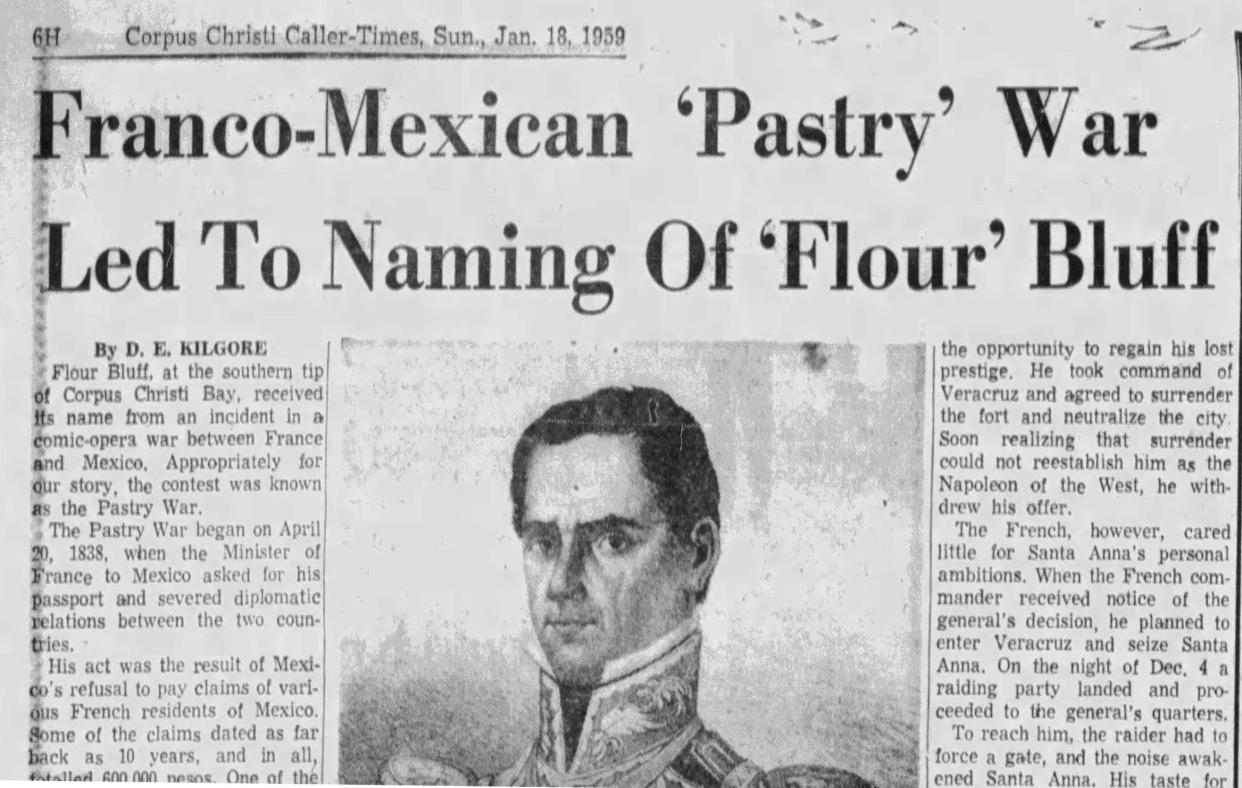#TBT: Flour Bluff’s name came from the aptly named Pastry War

Sometimes misspelled as flower, Flour Bluff in Corpus Christi has carried the name for a surprisingly long time. And the name, fittingly, came about during something called the Pastry War.
The Pastry War has a less whimsical name, the First Franco-Mexican War. The war, which lasted from 1838 to 1839, was fought over reparations owed to French merchants over looting by Mexican soldiers. One incident in particular dating back nearly a decade from the start of the war seems to be the basis of the name, a claim from a French pastry chef living near Mexico City whose bakery was looted.
The French proceeded to block Mexican ports, so naturally smuggling flourished along the Gulf Coast. Corpus Christi Bay became a lucrative route for smugglers. The Sept. 8, 1838, issue of the Telegraph and Texas Register newspaper carried an account from Col. Edwin Morehouse, whose militia interrupted Mexican smugglers unloading cargo onto the beach, to be brought overland to Mexico: 100 barrels of flour along with boilers and other parts of a steam engine, presumably for mining in the interior of Mexico. Thus, the "flour bluffs" name caught on.
More:#TBT: Downtown Corpus Christi nearly had an outdoor escalator in 1960s
A second account of the abandoned barrels of flour also turned up a decade later, this time in the Feb. 19, 1848, Pittsburgh Daily Post editorial column. Describing the boundary disputes of Texas during the final days of the Mexican-American War, this letter sent to the editor of the Washington Union newspaper by G.W. Fulton was reprinted by the Post. While detailing his experiences as a surveyor along the coast in Nueces and San Patricio counties, Fulton wrote of the famous flour barrels:
“In the fall of 1838, the schooner Lodi, from New Orleans, landed about 200 barrels of flour, intended for the Matamoros market; which port could not be entered on account of the French blockade. Information was brought me of the fact by a company of surveyors engaged in surveying lands west of the Nueces River, under the direction of the legally appointed surveyor of San Patricio County, which ... extended to the Rio Grande by the then-existing laws of Texas. The company of surveyors cut the hoops from the barrels, in sight of the Mexicans who had been left in charge. This point, on Corpus Christi Bay, is now known as Flour Bluffs, from this circumstance, and lies about ten miles west of the site of the present town of Corpus Christi.”
Regardless of the details, which don’t exactly match the report from Morehouse, the name stuck for the peninsula between the Cayo del Oso and the Laguna Madre.
Flour Bluff didn’t flourish as Corpus Christi did. Phillip Dimmit, a Texas Revolution hero, opened a trading post at Flour Bluff a year after Henry Kinney opened his trading post at what is now downtown Corpus Christi in 1840. Both posts were in land disputed by the U.S. and Mexico, and Dimmit’s post was raided by Mexican cavalry in 1841. Kinney’s post a mere 12 miles away was left untouched. Dimmit was taken to Mexico, where he overdosed on morphine rather than languish in prison. The raid was led by a friend of a friend of Kinney, and speculation was Kinney was getting rid of the competition.
The area remained little settled for the following decades, mostly a collection of fishing shacks. During the Civil War, Union sympathizers left homes in the Coastal Bend to camp out at Flour Bluff, including the John Anderson family from Corpus Christi and the Singer family from Padre Island. The land, formerly called Encinal Peninsula, became part of the Laureles Ranch owned by Mifflin Kenedy and eventually part of the Texas Land and Cattle Company. In 1891, developer Elihu Ropes purchased some of the land and attempted to rebrand the tract as “Flower Bluff Farm and Garden Tracts.” Ropes went bankrupt, but the Texas Land and Cattle Company took back the land and went ahead with the land tracts, and a farming community grew, helped along by the creation of the Don Patricio Causeway in 1927.
More:#TBT: How the Harbor Bridge caused a mayor’s resignation in 1954
But the Naval Air Station construction is what eventually brought Flour Bluff to life. The sand dunes at the point, some up to 40 feet tall, that had resembled the flour abandoned in 1838 were bulldozed for the new military base, and people arrived in droves. On Aug. 5, 1961, Corpus Christi annexed Flour Bluff, on the same day that Flour Bluff voted to incorporate. Despite vehement opposition and legal suits that eventually ended at the U.S. Supreme Court (but the court declined to hear), Flour Bluff became part of Corpus Christi.
Allison Ehrlich writes about things to do in South Texas and has a weekly Throwback Thursday column on local history.
This article originally appeared on Corpus Christi Caller Times: #TBT: Flour Bluff’s name came from the aptly named Pastry War

